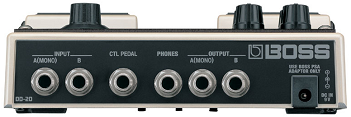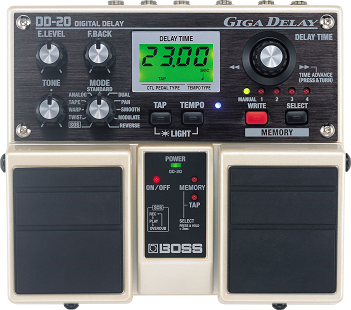DD-20
Boss DD-20 GigaDelay. This is actually a rather complicated pedal, and there are a couple of modifications available to reduce the white noise in the operation of the pedal. These are detailed below under "modifications". This double-pedal has been discontinued by Boss. While there are some complaints about the digital codec in the pedal not providing repeats in a fidelity that is as high as possible, we haven't noticed an issue. That said, this pedal is very versatile and has many features that most players might not ever necessarily use in the course of their performing. At first we were a bit surprised that production of the DD-20 was ended, but that the Boss RE-20 Space Echo continues to be produced. It would seem the DD-20 didn't sell as well as the RE-20. After going back and reviewing the Owner's Manual and writing the Wiki entry for this pedal, it's clear that as a pedal, the DD-20 is probably far more complicated than most casual musicians first expect. Compared to the RE-20, the configuration and functions are far more complicated. It's a fine pedal for a musician, but it takes a lot of working with, so it's not hard to see why it was outsold by the more familiar and less complicated RE-20.
Despite the fact that the DD-20 has since been obsolesced by the Boss DD-500, it's interesting to note that for 40 years Boss has been successful with pedals employing broad "metal cap/flap"-style footswitches. With the new success of Dunlop/MXR, and along with legions of boutique and home builders that use the simple button switches, it seems Digitech/DOD has been coaxed away from their previous transition to the Boss-style "metal cap/flap" switch and back to the button switch. Much of this seems to do with the fact that players have come to perceive that a button switch on the pedal signals that it's always true bypass. This seems in turn to have put Boss on the defensive and now Boss has returned to their CE-1 era button style footswitches for certain pedals, even if those switches do nothing to actually make the pedals true bypass.
Controls
- Knob 1 - "E. Level": (Effect Level) Fully counter-clockwise results in an inaudible delay effect. Fully clockwise results in repeats that are just as loud as the original dry signal before tapering off.
- Knob 2 - "F. Back": (Feedback) Select the number and intensity of repeats starting at fully counter-clockwise with one repeat and fully clockwise resulting in enough repeats to begin self-oscillating.
- Knob 3 - "Tone": Turned fully counter-clockwise this knob emphasizes bass; turned fully clockwise emphasizes treble frequencies in the delayed signal. The knob at noon results in delay repeats without any frequency alteration.
- Knob 4 - "Mode": Use the Mode knob to select among several delay types:
- Sound on Sound (SOS): Record loops with facility to record on top of the loop you've already recorded. On/Off light flashes in record/overdub mode, stays on in playback mode.
- Twist: Causes an acceleration in the delay and shifts the delayed note pitch up when the left pedal is depressed. When the pedal is released, the delay slows down and the pitch drops back down. On/Off light flashes when left pedal is held down in this mode.
- Warp: When the left pedal is pressed the number of delay repeats slowly increases. When pedal is released the number of delay repeats slowly returns to original setting. On/Off light flashes when left pedal is held down in this mode.
- Tape: Results in an effect similar to a tape delay where additional tape heads pick up signal and play it back. Holding down the On/Off pedal will allow you to use the Delay Time knob select between one or two tape heads in the delay effect.
- Analog: Frequency-tuned to sound like an analog delay. Treble frequencies are rolled off for delay repeats.
- Standard: Unmodified digital delay
- Dual: Sort of a slapback effect, not unlike the "Tape" setting but you can set the time (50-300 milliseconds) between the "dual" delay repeats. Holding down the On/Off pedal will allow you to use the Delay Time knob select the spread in the "dual" delay effect.
- Pan: Bounces the delay effect between the left and right stereo outputs
- Smooth: A delay effect that "smooths" the repeats with the addition of some built-in reverb.
- Modulate: Modulates the delay sound. As if you put your delay-wet output through a chorus pedal. Holding down the On/Off pedal will allow you to use the Delay Time knob to select the amount of rate and depth in the modulations of the delay effect.
- Reverse : A reverse-gated delay sound, makes your instrument sound like it's being played on a tape or record being played backwards.
- Knob 5 - "Delay Time": This is the largest knob and is used by other features in the pedal, but it's main purpose is to -
- simple knob-turn: speeds up or slows down delay by milliseconds.
- slight push-down with knob turn: speeds up or slows down delay by hundreds of milliseconds.
- Footswitch 1 (left) - "On/Off": This turns the pedal On and Off; helps set and control other features.
- Footswitch 2 (right) - "Select": Depending on the modes set for the pedal, this switch selects between the manual, and each of the 4 memory banks.
- Button 1 - "Tap": Tap this button to set the repeats to match your tempo. Holding down this button toggles the view of delay time from milliseconds to Beats-per-minute (BPM). Top of the unit has a "Control Pedal" jack which allows an additional pedal for use as tap tempo.
- Button 2 - "Tempo": Allows you to set the delay time in terms of note lengths, from quarter-note to triplets to dotted whole note. Please see Owner's Manual for a more in-depth description.
- Buttons 1 & 2 together: "Light": This controls whether the backlight on the digital display is on or off.
- Button (red) 3 - "Write":
- Button 4 - "Select": Use this button to select from among the four banks of delay settings you may have previously saved.
Input and Output Jacks
- Input A (mono)
- Input B
- Control Pedal Input
- Headphones Output
- Output A (mono - dry + wet)
- Output B (stereo or only Input B)
- AC Adapter Input
General Information
If you're using the pedal long-term in your signal chain, it'll help for you to configure the pedal to remember the different modes that you'd like for it to start up with in default when you power the pedal on.
Pedal Modes
Output Modes
We tried listing out the output modes individually, but when combined with understanding how to use a single input versus two inputs, it gets pretty difficult to conceptualize how everything is supposed to work without a lookup table...
| Output Mode | Operation | Input Jacks | Output Jacks | Sound Mix | Notes |
|---|---|---|---|---|---|
| 1 | -20dB (instrument) | Input A only | Output A only | dry + wet | "stereo" signal |
| 1 | -20dB (instrument) | Input A only | Output A Output B |
dry + wet dry + wet |
"stereo" "stereo" |
| 1 | -20dB (instrument) | Input A Input B |
Output A Output B |
dry + wet dry + wet |
Output A: Input A dry + wet Output B: Input B dry + wet |
| 2 | -20dB (instrument) | Input A only | Output A only | dry only | mono signal (dry only) |
| 2 | -20dB (instrument) | Input A only | Output A Output B |
dry wet |
Output A: dry Output B: wet |
| 2 | -20dB (instrument) | Input A Input B |
Output A Output B |
dry + wet dry + wet |
"stereo" "stereo" |
| 3 | +4dB (line level) | Input A only | Output A only | dry + wet | "stereo" signal |
| 3 | +4dB (line level) | Input A only | Output A Output B |
dry + wet dry + wet |
"stereo" "stereo" |
| 3 | +4dB (line level) | Input A Input B |
Output A Output B |
dry + wet dry + wet |
Output A: Input A dry + wet Output B: Input B dry + wet |
| 4 | +4dB (line level) | Input A only | Output A only | dry only | mono signal (dry only) |
| 4 | +4dB (line level) | Input A only | Output A Output B |
dry wet |
Output A: dry Output B: wet |
| 4 | +4dB (line level) | Input A Input B |
Output A Output B |
dry + wet dry + wet |
"stereo" "stereo" |
Additional Notes:
- We're using the Boss DD-20 Owner's Manual for the "stereo" terminology. What they mean by "stereo" seems to be a mono signal that is dry + wet. We believe this use of the term stereo is incorrect but use it to maintain continuity with the Owner's Manual.
- If in Output modes 2, and 4, if the pedal is "off" then no signal will go through Output B.
Looping Features
Sound-on-Sound mode.
Modifications
It should be possible to lower the hiss that some hear in their pedals. We will likely be making this modification as soon as is reasonably possible.
From:
Recently I became interested in improving the sound of my DD-20 Giga Delay. To that end I replaced the original cheap/low performance M5218 and NJM2100 op amps with modern low noise/high performance OPA1612 and OPA2365 respectively. Additionally, I added film bypass capacitors across the electrolytics which couple the various analog stages. Bypass capacitors help retain transparency in AC coupled circuits.
...
(later in the thread...)
The initial change to OPA1612s raised the quiescent current draw of the DD-20 to over 200ma which was a slight cause for concern; although I tried to track down possible oscillation I was unable to find anything with an oscilloscope. However, after switching to OPA1642s the current draw is now closer to 180ma, with perhaps slightly less background hiss.
Sometime soon I'm planning on revisiting the high-cut capacitors in the delay path because I'm getting a little aliasing distortion when used with my homemade A/DA flanger. I don't mind to lose a little bit of treble on the delayed signal. My biggest reason for making modifications was to open up the frequency response in the dry/bypassed path. Without modification, the DD-20 is a bit of a "tone sucker" IMO.
Pedal Manual
https://static.roland.com/assets/media/pdf/DD-20_OM.pdf
Phase Inversion
No schematic means that we're unable to determine, without an oscilloscope, if the DD-20 inverts the signal phase. That said, the schematic is probably so complicated that it would be almost impossible for the lay person to be able to trace and determine whether this pedal inverts. Once we get it up on a bench with an oscilloscope, we'll report here if the phase is inverted.
Schematic
None available.
Artists
- Additional Sources

